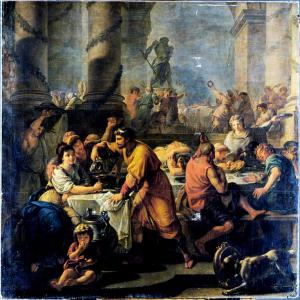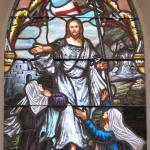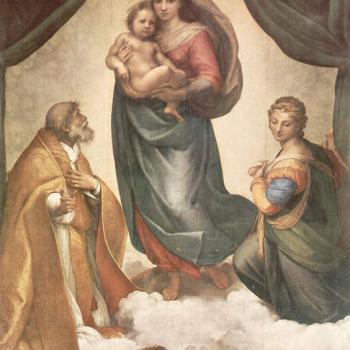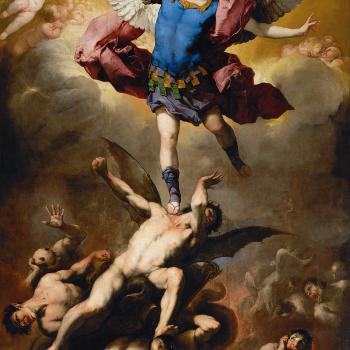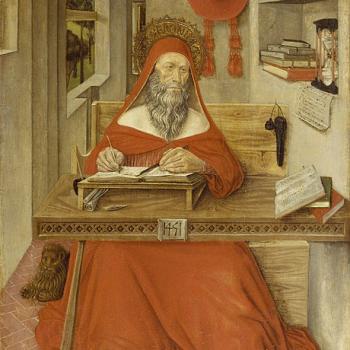Nor from Sol Invictus . . .
These are commonly repeated myths that have become part and parcel of those who like to speculate about history and the alleged connections between pagan Roman festivals and Christmas. I used to accept it myself — and spread it through my writing –, before I looked into it more deeply. In some cases, such “baptizing” of pagan customs do indeed happen, but it looks it’s not the case in this instance.
First of all, the date of December 25th for the birth of Jesus, is a straightforward deduction from Scripture, analyzed in conjunction with historical knowledge about those who worked in the temple. In other words, it was derived from considerations having nothing whatsoever to do with Roman festivals or any other December-related cultural or non-Christian religious activities.
Fr. William Saunders, in one of his consistently excellent articles for The Arlington Catholic Herald (12-19-13), wrote:
St. Luke related the announcement of the birth of St. John the Baptist to his elderly parents, St. Zechariah and St. Elizabeth. St. Zechariah was a priest of the class of Abijah (Lk 1:5), the eighth class of 24 priestly classes (Neh 12:17). Each class served one week in the temple, twice a year.
Josef Heinrich Friedlieb has established that the priestly class of Abijah would have been on duty during the second week of the Jewish month Tishri, the week of the Day of Atonement or in our calendar, between Sept. 22 and 30. While on duty, the Archangel Gabriel informed Zechariah that he and Elizabeth would have a son (Lk 1:5-24). Thereupon, they conceived John, who after presumably 40 weeks in the womb would have been born at the end of June. For this reason, we celebrate the Nativity of St. John the Baptist June 24.
St. Luke also recorded how the Archangel Gabriel told Mary that Elizabeth was six months pregnant with John (Lk 1:36), which means the Annunciation occurred March 25, as we celebrate. Nine months from March 25, or six months from June 24, renders the birth of Christ at Dec. 25, our Christmas.
Marty Barrack adds:
Shemaryahu Talmon, Professor Emeritus in the Bible Department at Hebrew University in Jerusalem and a top Scroll scholar, in 1958 published an in-depth study of the Temple’s rotating assignment of priests [1 Chr 24:7] [Dave: see 1 Chr 24:10; cf. 24:1-19] and the Qumran scrolls to see the assignment during New Testament times. It shows definitively that Zachariah served as a Temple priest [Lk 1:8] in September.
Early Christian history corresponds to this, as Fr. Saunders noted in another article:
[A]ccording to the Liber Pontificalis, Pope St. Telesphorus (125-136) instituted the tradition of celebrating midnight Mass, which means Christmas already was being celebrated. St. Theophilus (AD 115-181), bishop of Caesarea, stated, “We ought to celebrate the birthday of Our Lord on what day soever the 25th of December shall happen.” [Magdeburgenses, de orign Festorum Chirstianorum] St. Hippolytus (170-240) mentioned in his Commentary on Daniel [4.23.3; written in 204 AD] that the birth of Christ occurred Dec. 25 [“For the first advent of our Lord in the flesh, when he was born in Bethlehem, was December 25th”].
After Constantine legalized Christianity in 313, the church was able to establish universal dates for the celebration of feast days, including Christmas and the Annunciation. As such, evidence shows the celebration of Christmas Dec. 25: Pope Liberius (352-66) celebrated Christmas Mass in Rome; St. Gregory Nazianzus (d. 389) in Constantinople, and St. Ambrose (d. 397) in Milan. [also, St. John Chrysostom preached a Christmas sermon on December 25th, 386]. Keep in mind that they would not have just “picked a date,” but used the date already accepted by the church. [my bolding and bracketed comments added]
[see also a defense of the authenticity of the Hippolytus citation, and a second one by the same person, Dr. Tom C. Schmidt]
Classicist Peter Gainsford described Saturnalia:
Christmas has absolutely nothing to do with Mithras or Saturnalia. . . .
Saturnalia was a Roman festival of Saturn on 17 December. Celebrations continued after Saturnalia for several days, finishing sometime between 19 and 23 December depending on which century we’re talking about. It may originally have been a farming festival; the evidence is unclear. It was associated with an overturning of various regulations and social norms: free citizens often wore a freedman’s hat, the pilleus, and played gambling games that were normally illegal; slaves would dine alongside their masters, or even act the part of master. People would exchange gifts of candles and clay figurines.
There’s no link to Christmas. The date? No: they’re not on the same date. . . . The fact that Saturnalia might have had some chance to have an influence on Christmas isn’t evidence that it did.
Christmas trees? Yule logs? Holly and ivy? No, none of those come from Saturnalia. Individual customs may have pagan origins in some cases — the Yule log may possibly be based on a late mediaeval Anglo-French or South Slavic custom — but that has nothing to do with the claim that Christmas is based on Saturnalia.
Gift-giving? No: the magi may have given tribute to Jesus (traditionally at Epiphany, 6 January), but the modern custom of gift-giving at Christmas only goes back to the 16th century. That is when Luther introduced the Christkind in an attempt to discourage veneration of St Nicholas, who was associated with gift-giving on his feast day of 6 December. In late mediaeval Germany gift-giving had also been associated with the feast of the Holy Innocents, on 28 December. It’s possible that Christmas charity from aristocrats to the poor goes back a bit further. But there’s certainly no evidence to suggest continuity all the way back to when Saturnalia was still being celebrated. (“Christmas and its supposed pagan links”, Kiwi Hellenist, 12-24-15)
Another candidate for a pagan Roman festival that Christmas supposedly appropriated or incorporated or supplanted is Sol Invictus, which at least fell on December 25th. But the earliest date provided by historical evidence, for the Roman celebration of Sol Invictus is 274, when it was instituted by the Roman emperor Aurelian. But the December 25th date for this festival did not begin in 274. It came eighty years later:
[U]pon examination, the notion that the cult of Sol in late Antiquity represented a new pagan religion that potentially threatened to thwart Christianity, is not supported by any clear evidence. . . .
[T]here is no evidence that Aurelian instituted a celebration of Sol on that day [December 25]. A feast day for Sol on December 25th is not mentioned until eighty years later, in the Calendar of 354 and, subsequently, in 362 by Julian in his Oration to King Helios.
In short, while the winter solstice on or around the 25 of December was well established in the Roman imperial calendar, there is no evidence that a religious celebration of Sol on that day antedated the celebration of Christmas, and none that indicates that Aurelian had a hand in its institution. (“Sol: the sun in the art and religions of Rome”; dissertation by
After reviewing the evidence of a December 25th date in the pagan Roman calendar,
None of this tells us when the natalis invicti of December 25 entered the Roman calendar, but on this evidence we must acknowledge that it is a real possibility that it did not do so until after the bishop of Rome first celebrated Christmas on that day – a pagan reaction to a Christian feast, perhaps, rather than vice versa.
And this is the same conclusion as Fr. William Saunders: “Christmas was celebrated Dec. 25 prior to any pagan celebration on the same date.” The Chronicon Blog adds further relevant details:
I have found the full Latin of the inscription which Roll (“Toward the Origins of Christmas”) implies states that Emperor Aurelian set up a feast for Sol Invictus on December 25 in 274AD. The Latin inscription can be found here (it is a transcription, sadly no picture is provided) it is number 580 (Inscriptiones Latinae Selectae by Hermann Dessau.) As we will see the inscription says no such thing about December 25 . . . (“Sol Invictus evidently not a precursor to Christmas”, 12-21-10)
Whatever date one thinks marked the beginning of the observance of Sol Invictus on December 25th, it’s anywhere from 70-220 years after Christian bishops and popes were celebrating Christmas on that date, and Church father Hippolytus taking note of the date (in 204 AD). So this myth can be safely laid to rest, too.
Andrew McGowan (no insignificant scholar) wrote:
[E]arly Christian writers never hint at any recent calendrical engineering; they clearly don’t think the date was chosen by the church. Rather they see the coincidence as a providential sign, as natural proof that God had selected Jesus over the false pagan gods.
It’s not until the 12th century that we find the first suggestion that Jesus’ birth celebration was deliberately set at the time of pagan feasts. A marginal note on a manuscript of the writings of the Syriac biblical commentator Dionysius bar-Salibi states that in ancient times the Christmas holiday was actually shifted from January 6 to December 25 so that it fell on the same date as the pagan Sol Invictus holiday. In the 18th and 19th centuries, Bible scholars spurred on by the new study of comparative religions latched on to this idea. (“How December 25 Became Christmas”, Bible Review, Dec. 2002; reprinted in Bible History Daily, 12-3-17)
Spencer McDaniel sums up:
The Christmas season is upon us and, if there’s one thing I know I’m going to get for Christmas, it’s spurious claims about modern Christmas traditions supposedly having ancient “pagan” origins. . . .
Well, I’m here to tell you that, although there was a time when Christmas did indeed incorporate some pre-Christian traditions, virtually none of the traditions associated with Christmas in the United States today are actually of ancient pre-Christian origin. In fact, virtually all of the Christmas traditions that you usually hear people going around claiming are “pagan” are actually traditions that only arose within the past two hundred years or so, within a Christian cultural context. . . .
The Syrian writer Loukianos of Samosata (lived c. 125 – after c. 180 CE) gives a somewhat more vivid description of what celebrations of the holiday were often like in his dialogue Saturnalia. He writes, as translated by H. W. and F. G. Fowler:
“[During Saturnalia] the serious is barred; no business allowed. Drinking and being drunk, noise and games and dice, appointing of kings and feasting of slaves, singing naked, clapping of tremulous hands, an occasional ducking of corked faces in icy water…”
It’s clear from these ancient descriptions that Saturnalia was a rather rowdy holiday and that it was in many ways closer to a modern Mardi Gras celebration than a modern Christmas celebration. . . .
[A]s far as I can tell, the ancient Roman custom of giving gifts for Saturnalia and the modern custom of giving gifts for Christmas are actually unrelated. The tradition of giving gifts for a holiday in December seems to have died out in late antiquity and it does not seem to have begun to remerge until around two centuries ago. . . .
Ironically, the idea that Christmas is pagan actually comes from die-hard Protestant fundamentalists in the seventeenth, eighteenth, and nineteenth centuries. In those centuries, many Protestants regarded holidays like Christmas and Easter as “popery” and therefore sought to discredit them by linking them with ancient paganism. The idea that Christmas might be pagan was advanced as early as 1648 in the work Certain Queries Touching the Rise and Observation of Christmas, written by the Puritan Joseph Heming. Later fundamentalist writers really took the idea and ran with it.
One particularly influential writer was Alexander Hislop (lived 1807 – 1865), a minister for the Free Church of Scotland who published a pamphlet in 1853 titled The Two Babylons. In this pamphlet, Hislop claimed that Roman Catholicism is really nothing more than re-branded Babylonian paganism and that all the holidays associated with Catholicism are actually ancient Babylonian religious festivals in honor of the heathen gods. Hislop was a zealot and a crank whose ideas had almost no factual basis whatsoever, but his work became extremely influential among Protestant fundamentalists. (“Just How Pagan Is Christmas Really?”, 12-8-19; this long article is a goldmine of information about various traditions claimed to derive from Saturnalia or other pagan feasts; see also his article, “How Was Saturnalia Celebrated in Ancient Rome?”, 12-18-20)
***


